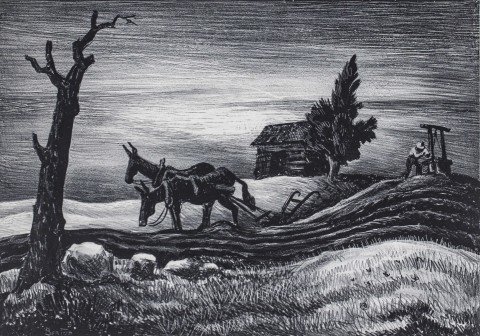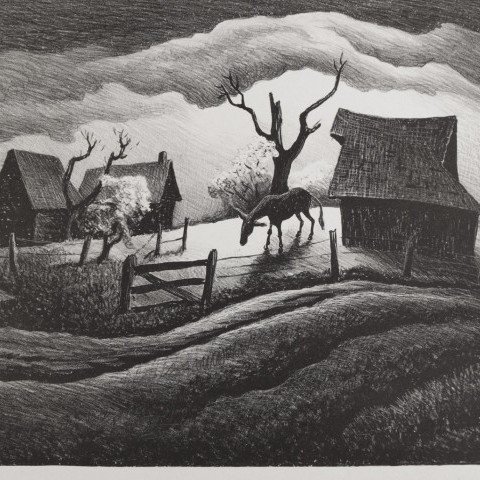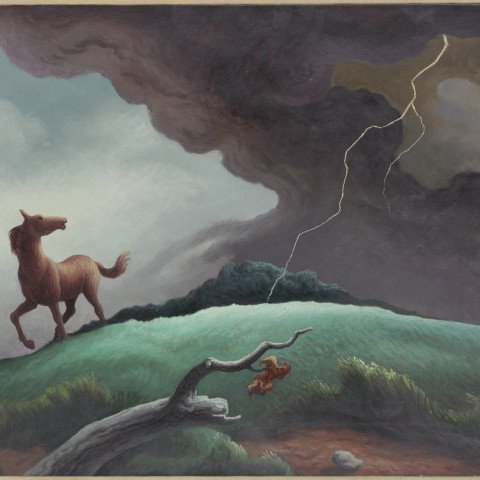Likely the most important painter of the American Scene movement, Thomas Hart Benton created a style and addressed subject matter that was uniquely American as well as specific to his state of Missouri, and that combined elements of modernism and realism. His signature painting was regionalist genre, especially laboring figures. In addition to many murals, he also painted landscapes and portraits.
Benton was a highly intelligent, energetic, flamboyant, pugnacious and hard drinking fellow, who quite often found himself in the center of controversy. As a student, he was unruly and alienated many of his peers and teachers.
Thomas Hart Benton was born in Neosho, Missouri, and named for a great uncle and early United States Senator. His father, Colonel M.E. Benton, was a Congressman for eight years, and during the winter, the family lived in Washington D.C. and in Neosho in the summer. At age 17, after the family had returned to Missouri, he took a summer job as cartoonist on The Joplin American. Determined to pursue his talent, he later said he had to run away from home to become an artist.
In 1907-1908, he studied with Frederick Oswald at the Art Institute of Chicago* and then studied in Paris for three years including briefly at the Academie Julian* under Jean-Paul Laurens and for a longer period at the Academie Collarossi, where he could work independently.
In 1911, Colonel Benton decided he could no longer support his son in Paris, so Tom went to New York. Between 1910 and 1920, he experimented with styles of Impressionism, Neo-Impressionism, Post-Impressionism, and Synchromism, the last influenced by his friend, Stanton MacDonald-Wright. For much of this time, he was a dedicated modernist, but a fire destroyed most of the examples of his painting from this time period.
"His draftsman experience in the Navy, 1918-19, led to his American Scene realist style beginning with his circa 1921 West Side Express. That recently-surfaced masterwork painted for the educator Caroline Pratt, led to many ciryscapes and the never-commissioned 17-panel mural project that he titled, The American Historical Epic (1922-27 ).
He set aside the "Epic" to travel America for two years collecting drawings. He had already completed his research when Alvin Johnson commissioned his America Today murals (1930-31) for the New School for Social Research in New York City. This ground-breaking work (now in the collection of the Metropolitan Museum of Art) earned him much respect and many important mural commissions. Its fame was key to the support of artists in the Federal Art Projects. (McCraw)
His murals at the Missouri State Capitol in Jefferson City are major American Scene murals, and in 1957, he was commissioned by Robert Moses, chairman of the board of the Power Authority of the State of New York to paint a mural for the Power Authority at Massena.For this work at the site, he did extensive research on the theme, which was the Canadian expedition of Jacques Cartier in the mid 1500s.
The early part of his career he lived in New York City where he taught at the Art Students League and became a major influence on the style of gestural painter, Jackson Pollock. But increasingly Benton grew to believe that art should express one's surroundings rather than abstract ideas and that the ordinary person most exemplified American life. Many of these ideas he inherited from his Populist father who served as a Congressman from Missouri from 1897 to 1905.
From 1935, he established a studio in Kansas City from where he painted for the next forty years until his death at age 85.
He was both a prolific lithographer, completing 80 lithographs between 1929 and 1945, and writer including two autobiographies, An Artist in America, and An American In Art. Fellow Missourian and former United States President Harry Truman said that Benton was "the best damned painter in America."
Source:
Matthew Baigell, Dictionary of American Art and Thomas Hart Benton
Fred McCraw (Email sent to AskART.com)



![Morning Train [Soldier’s Farewell] by Thomas Hart Benton](https://wolfsgallery.com/images/works/_grid/thomas-hart-benton-morning-train-1.jpg)
